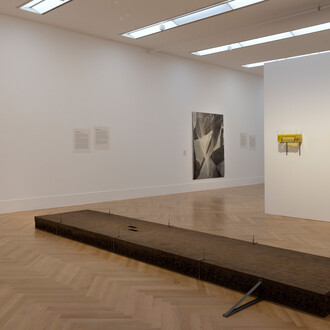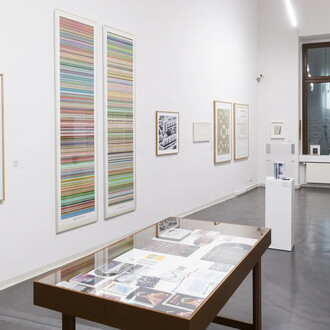With Interactions 2024, we once again invite you to spend the summer in the public outdoor and indoor spaces of the Bundeskunsthalle, where new works of art will complement the existing ones: Jeppe Hein’s water pavilion Circular appearing rooms, which is presented on the square every summer, and Carsten Höller’s Bonn Slide, which winds along the façade and rotates on its own axis.
The new works of art also invite you to play, reflect, or linger. All the works have their own story to tell, which can be discovered through interaction, but they also deal with different “visual languages” as a universal form of communication that transcends borders.
This year sees the addition of Gabriel Lester’s large installation Bouncer on the roof, which enables a collective but also individual spatial experience by passing through a series of swinging doors as if in stop-motion.
Linda Nadji offers a mental bridge between inside and outside with Meanwhile, two gilded high seats, one on the roof and one in the foyer, questioning the possibilities of communication through the unusual change of perspective.
Clare Strand’s fun fair stand All that hoopla is a playful reflection on the mechanisms of the art market.
Interactions, interventions and irritations give the opportunity to actively participate in art.
Temitayo Ogunbiyi enriches the parcourse on the Museum Square with an organic climbing composition made of several steel rods wrapped in plant fibres. The shapes of these rods, inspired by plants and strands of hair, interpret the lines that connect Lagos in Nigeria to the Rhine and thus to various communities in Europe.
Esra Gülmen’s seesaws entitled Controversy teeter-totter offer a playful way of finding a balance between two opposing statements, while Finnegan Shannon’s hand-lettered benches Do you want us here or not invite visitors to pause and offer a place for reflection in dialogue with the other works. In their audio pieces Meet me at the bench, the Ligna artist collective also explores the bench as a place of communication or lingering.
Olaf Nicolai’s football goal walls on the south lawn promote individual and collective competition and bring different cultural and temporal levels “into play” in terms of content, while the bouncy castle Seele und dekor (Soul and décor) by the artist duo Famed puts Karl Marx’s treatise Das kapital on a shaky foundation.
Jonas Lund presents his digital racing game on the LED wall at intervals, with colours and shapes whizzing by. This can be used as a computer game in the salon, as can Temitayo Ogunbiyi’s You will flow, which offers a virtual playground experience.
Last but not least, Tomas Kleiner’s Aufbruch in die schwebe (rising into the void) takes us into the bearable “lightness of being”.
All these works demonstrate that art can be an open offer, serving both individual and shared experiences – a togetherness in which rigid roles and behaviours are questioned and openness, tolerance and sensitivity are encouraged. All the participating artists are interested in forms of expression and techniques that reduce the possible distance to art, as well as the distance within a complex, diverse society.
















